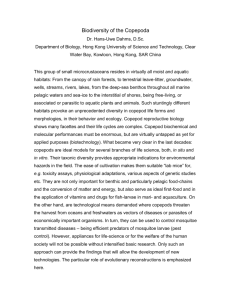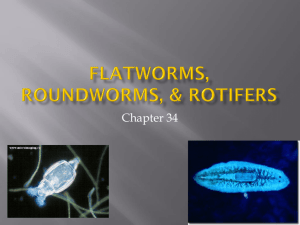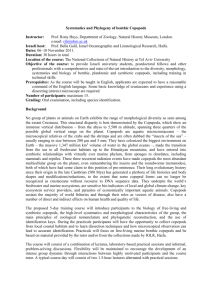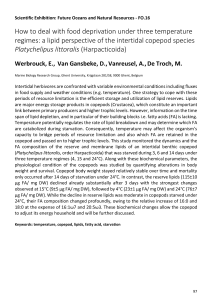neotropical vol. 9 nº1
advertisement
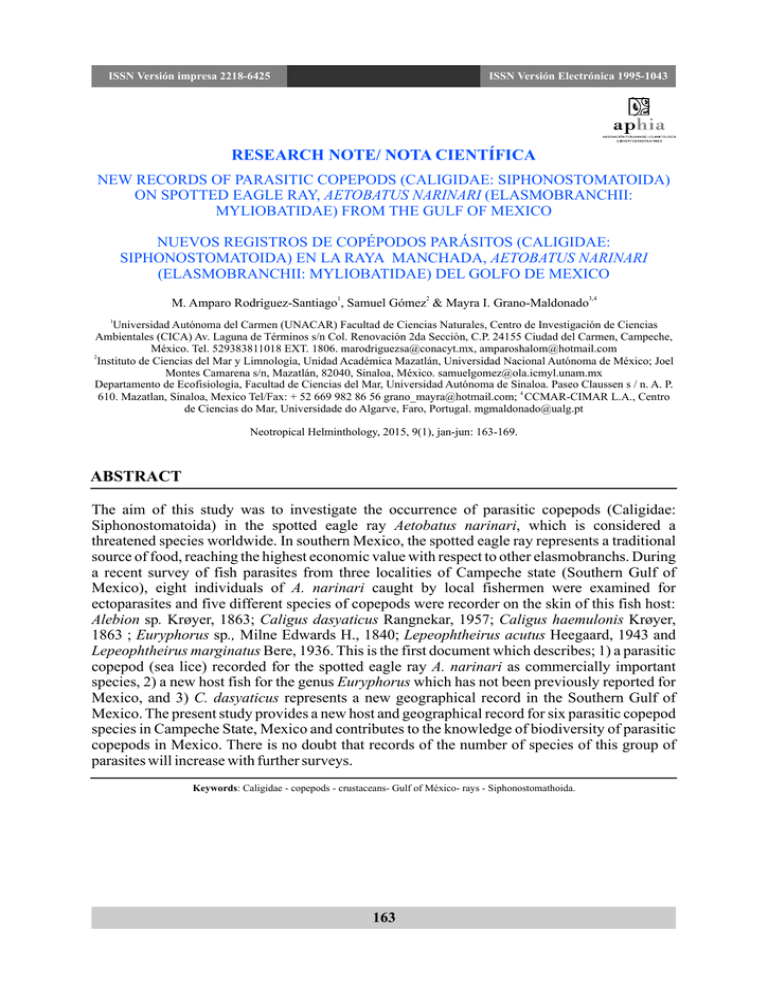
ISSN Versión impresa 2218-6425 ISSN Versión Electrónica 1995-1043 RESEARCH NOTE/ NOTA CIENTÍFICA NEW RECORDS OF PARASITIC COPEPODS (CALIGIDAE: SIPHONOSTOMATOIDA) ON SPOTTED EAGLE RAY, AETOBATUS NARINARI (ELASMOBRANCHII: MYLIOBATIDAE) FROM THE GULF OF MEXICO NUEVOS REGISTROS DE COPÉPODOS PARÁSITOS (CALIGIDAE: SIPHONOSTOMATOIDA) EN LA RAYA MANCHADA, AETOBATUS NARINARI (ELASMOBRANCHII: MYLIOBATIDAE) DEL GOLFO DE MEXICO M. Amparo Rodríguez-Santiago1, Samuel Gómez2 & Mayra I. Grano-Maldonado3,4 1 Universidad Autónoma del Carmen (UNACAR) Facultad de Ciencias Naturales, Centro de Investigación de Ciencias Ambientales (CICA) Av. Laguna de Términos s/n Col. Renovación 2da Sección, C.P. 24155 Ciudad del Carmen, Campeche, México. Tel. 529383811018 EXT. 1806. marodriguezsa@conacyt.mx, amparoshalom@hotmail.com 2 Instituto de Ciencias del Mar y Limnología, Unidad Académica Mazatlán, Universidad Nacional Autónoma de México; Joel Montes Camarena s/n, Mazatlán, 82040, Sinaloa, México. samuelgomez@ola.icmyl.unam.mx Departamento de Ecofisiología, Facultad de Ciencias del Mar, Universidad Autónoma de Sinaloa. Paseo Claussen s / n. A. P. 610. Mazatlan, Sinaloa, Mexico Tel/Fax: + 52 669 982 86 56 grano_mayra@hotmail.com; 4 CCMAR-CIMAR L.A., Centro de Ciencias do Mar, Universidade do Algarve, Faro, Portugal. mgmaldonado@ualg.pt Neotropical Helminthology, 2015, 9(1), jan-jun: 163-169. ABSTRACT The aim of this study was to investigate the occurrence of parasitic copepods (Caligidae: Siphonostomatoida) in the spotted eagle ray Aetobatus narinari, which is considered a threatened species worldwide. In southern Mexico, the spotted eagle ray represents a traditional source of food, reaching the highest economic value with respect to other elasmobranchs. During a recent survey of fish parasites from three localities of Campeche state (Southern Gulf of Mexico), eight individuals of A. narinari caught by local fishermen were examined for ectoparasites and five different species of copepods were recorder on the skin of this fish host: Alebion sp. Krøyer, 1863; Caligus dasyaticus Rangnekar, 1957; Caligus haemulonis Krøyer, 1863 ; Euryphorus sp., Milne Edwards H., 1840; Lepeophtheirus acutus Heegaard, 1943 and Lepeophtheirus marginatus Bere, 1936. This is the first document which describes; 1) a parasitic copepod (sea lice) recorded for the spotted eagle ray A. narinari as commercially important species, 2) a new host fish for the genus Euryphorus which has not been previously reported for Mexico, and 3) C. dasyaticus represents a new geographical record in the Southern Gulf of Mexico. The present study provides a new host and geographical record for six parasitic copepod species in Campeche State, Mexico and contributes to the knowledge of biodiversity of parasitic copepods in Mexico. There is no doubt that records of the number of species of this group of parasites will increase with further surveys. Keywords: Caligidae - copepods - crustaceans- Gulf of México- rays - Siphonostomathoida. 163 Neotropical Helminthology. Vol. 9, Nº1, jan-jun 2015 Rodríguez-Santiago et al. RESUMEN El objetivo de este estudio, fue investigar la ocurrencia de copépodos parásitos (Caligidae: Siphonostomatoida) en la raya pinta Aetobatus narinari considerada una especie amenazada mundialmente. En el sur de México, la raya manchada representa una fuente tradicional de alimento, alcanzando el valor económico más alto con respecto a otros elasmobranquios. Durante un reciente estudio de parásitos de peces de tres localidades del estado de Campeche (sur del Golfo de México), ocho individuos de A. narinari capturados por pescadores locales fueron examinados por ectoparásitos y cinco especies diferentes de copépodos fueron registrados en la piel de este pez: Alebion sp. Krøyer, 1863; Caligus dasyaticus Rangnekar, 1957; Caligus haemulonis Krøyer, 1863; Euryphorus sp., Milne Edwards H., 1840; Lepeophtheirus acutus Heegaard, 1943 and Lepeophtheirus marginatus Bere, 1936. Este trabajo es el primero en documentar; i) un copépodo parásito (piojo de mar) registrado para la raya pinta A. narinari como especie de importancia comercial, ii) un nuevo hospedero para el género Euryphorus que no había sido reportado previamente para México y iii) C. dasyaticus representa una nueva registro geográfico en el Sur del Golfo de México. El presente estudio registra un nuevo hospedero y registro geográfico para seis especies de copépodos parásitos en el Estado de Campeche, México y contribuye al conocimiento de la biodiversidad de los copépodos parásitos en México. No hay duda de que el número de registros de especies de este grupo de parásitos se incrementará con nuevos estudios. Palabras claves: Caligidae- copépodos - crustáceos- Golfo de México - rayas - Siphonostomathoida. INTRODUCTION The spotted eagle ray Aetobatus narinari (Euphrasen, 1790) is currently considered as a threatened species by the Red List of the International Union for Conservation of Nature IUCN red list, because of their low reproductive potential and intense and unregulated fishing, which probably have caused the decline of their populations (Kyne & White, 2006; Compagno, 1999). In the Southern Gulf of Mexico, the spotted eagle ray still remains as a target species for fisheries. In fact, it is the second most captured batoid in the region (about 40 tons/year) (Conapesca, 2013). Only after the southern stingray Dasyatis americana (Hildebrand & Schroeder, 1928). Despite its importance, studies about its parasitofauna are in general scarce, particularly those related with parasitic copepods that may affect them. The impact of sea lice (a common name used for copepodos parasites) is well known to cause serious cutaneous lesions and mortality in farmed teleosts (Costello, 2009) where they graze the epidermis, often inducing secondary infections (Benz, 1981). So far, species of parasitic copepods found world-wide in aquatic environments, males are free-living in the zooplankton and only females are parasitic and found on fish hosts (Kabata, 1988a,b), causing destruction of gill tissue, emaciation, and sometimes death (Dezfuli et al., 2011). Most species are found on freshwater fishes, but a few infect marine fishes of coastal waters (Boxshall & Halsey, 2004a,b). Luque & Tavares (2007) reported 26 valid species plus 10 unidentified species of copepods, of which 23 are from freshwater hosts and 13 are from 164 Neotropical Helminthology. Vol. 9, Nº1, jan-jun 2015 Parasitic copepods on spotted eagle ray brackish or marine hosts in Brazil. Brooks (1992) reported helminths from stingrays in the neotropics and later, Domingues & Marques (2010) reported copepods of freshwater stingrays (Potamotrygonidae) in Brazil. In the case of Lepeophtheirus species primarily infect teleosts; nevertheless, a few have been reported from chondrichthyans infecting skin, gills and nasal cavities (Yamaguti, 1963; Cressey, 1967; Kabata, 1979a,b). Little is known about the host–parasite interactions of most copepods species in rays. Along with these new records reported in the present study, copepods have been currently reported on some elasmobranches mainly sharks from Mexico (Alvarez & Winfield, 2001). Therefore, the aim of this study is to identify (by traditional morphological methods) and quantify the parasitic copepods of A. narinari, a commercially important species in the southern Gulf of Mexico. MATERIAL AND METHODS Eight spotted eagle ray were obtained from landings of small fishing boats at three locations of Campeche, Mexico, at the southern Gulf of Mexico; San Pedro (18°.64'09?N, 92°46'88?S), Champotón (19°21'N 90°43'W) and and Seybaplaya (17°51'N 89°06'W) in 2013. Fish specimens were sacrificed by decapitation to ensure a fast dead, which is according to Mexican laws (NOM-033-ZOO-1995). Fish samples were transported in individual plastic bags in a cool box to Institute of Marine Sciences and Limnology, National Autonomous University of Mexico del Carmen Research Unit (ICMYL-UNAM) for parasitological examination. The total length (cm) and weight (g) were measured. All fish were examined for the presence of parasitic copepods on skin, fins, gills and gill rakers, the examination of copepods on the body surface of the hosts and gill arches were removed from each fish and carefully inspected in a Petri dish using a stereomicroscope (LEICA MZ9.5). The plastic bag contents were also examined for the presence of detached copepods. Parasites found on each fish were preserved in labeled vials with 70% ethanol until its taxonomic identification to the lowest level possible (Vidal-Martínez et al., 2002). Copepods identification was performed following Cressey & Boyle (1980, 1985), Kabata (1979a,b, 1992a,b), and Boxshall & Halsey (2004a,b). RESULTS Eight individuals of spotted eagle ray were examined, which measured between 160 cm length and 190 cm width. A 70% of examined fish specimens harbored at least one parasite taxon. A total of six parasitic copepod species (Caligidae, Siphonostomatoida) were found in eight specimens of A. narinari: Alebion sp. Krøyer, 1863 (see Boxshall, 2014); Caligus dasyaticus Rangnekar, 1957 (see Boxshall, 2013); Caligus haemulonis Krøyer, 1863 (see Boxhall & Walter, 2014a,b); Euryphorus sp., Milne Edwards H., 1840; Lepeophtheirus acutus Heegaard, 1943 (see Walter & Boxshall, 2009) and Lepeophtheirus marginatus Bere, 1936 on the skin of this fish host. The most abundant copepod parasite was Euryphrus sp. and the less abundant and was Alebion sp. DISCUSSION In the Neotropical zone, the importance of copepods, according to Luque & Poulin (2008), is that these organisms constitute the second and third largest parasitic group on marine and freshwater fishes, respectively. In this study, the spotted eagle ray A. narinari as 165 Neotropical Helminthology. Vol. 9, Nº1, jan-jun 2015 Rodríguez-Santiago et al. commercially important studied are economically important in the region, and further work will continue based on parasite biodiversity in order to understand their ecological importance, their biogeography and evolution, and to support and improve management and conservation strategies. Most of the copepods infecting fish and also elasmobranchs are mainly member of the family Siphonostomatoida, which consist of 39 families (Boxshall, 2013) and around of 210 chondrichthyan species may be infected by this family (Campagno, 1999). The species C. dasyaticus are a common parasite on the stingrays in India (Pillai, 1968); Japan (Tang et al., 2013) and Taiwan (Ho et al., 2007). Also, L. acutus has been reported from elasmobranches in Germany, Japan and the Netherlands (Tang et al., 2013; Kik et al., 2011). In eastern India (George et al., 2007) and South Africa (Lebepe & Dippenaar, 2013), given its ability to infect a wide variety of elasmobranchs and promote life-threatening lesions on some hosts, L. acutus should be considered a dangerous pathogen of captive elasmobranchs (Kik et al., 2011), in Thailand (Purivirojkul et al., 2009). This supports the hypothesis that intensity of infection is a species characteristic and that the biological features of parasitic species can potentially override local environmental conditions in driving parasite population dynamics. According to Poulin (2006), this is possible because prevalence is determined by encounter rates between parasites and hosts, which are influenced by processes external to the fish (e.g., survival of free-living parasite stages), probably determined by local factors, whereas intensity of infection is determined to a large extent by processes acting within the fish. This study increases our knowledge of the biodiversity of parasitic copepods in Mexico and provides a baseline of new information on the distribution of species of parasitic copepods in rays from the Gulf of Mexico, including new host records and new locality records. The only published reports of parasitic copepods Dinemoura latifolia (Steenstrup & Lütken, 1861) and Pandarus smithii Rathbun, 1886 found in sharks in the Gulf of Mexico were reported from Veracruz State by Alvarez & Winfield (2001) and secondly, a recent review by Morales-Serna et al. (2012), however, this does not show previous records on rays. Although some work has been perfomed, still a lack of knowledge which impede our understanding of the ecological and biogeographical history of the hostparasite associations. The ecological studies of parasitic copepods in commercially important fish species like sharks and rays which are important due to a high market value. Also, this fish species is highly appreciated by its meat, texture and flavor. The limitation of the study is that these fish species are not abundant in the commercial fishing or sport-fishing from this zone in México, despite being a common target for local commercial fisheries. Consequently, their capture just to perform parasitological studies is limited. This study identified the copepod parasitic fauna of commercially important ray species, which has been highlighted and shed some light on the knowledge of biodiversity and biology of parasitic copepods. New geographical host records are important, for the reason that you can detect distribution patterns. Studies on copepod parasitizing other commercial fish hosts, particularly in Mexico and Gulf of Mexico, and the completion of their life cycle warrant further investigation. In conclusion, this is the first to document which describes; i) a parasitic copepod (sea lice) record for the spotted eagle ray A. narinari as commercially important species in the Southern Gulf of Mexico, ii) a new host fish for the genus Euryphorus which has not been previously reported for Mexico. The present study provides new host and geographical record for six parasitic copepod species in Campeche State, Gulf of Mexico and 166 Neotropical Helminthology. Vol. 9, Nº1, jan-jun 2015 Parasitic copepods on spotted eagle ray BIBLIOGRAPHIC REFERENCES Alvarez, F & Winfield, I. 2001. New records of Dinemoura latifolia and Pandarus smithii (Copepoda, Siphonostomatoida, Pandaridae) parasitizing the shark Isurus oxyrinchus in the Gulf of Mexico. Crustaceana, vol. 74, pp. 501–503. Benz, G W. 1981. Observations on the attachment scheme of the parasitic copepod Pandarus satyrus (Copepoda: Pandaridae). Journal of Parasitology, vol.67, pp. 966-967. Boxshall, G. 2013. Shiponostomatoida. In: Water, TC, Boxhall, G. World of Copepods database. Consultado el 4 de O c t u b r e 2 0 1 4 , <http://www.mrinespecies.org/copepod a/aphia.php?p=taxdetails&id=104> Boxshall, G. 2014. Alebion Krøyer, 1863. In: Walter, TC & Boxshall, G. 2014. World of<http://www.marinespecies.org/cope poda/aphia.php?p=taxdetails&id=1355 88 on 2014-10-03 > Boxshall, GA & Halsey, SA. 2004a. Copepod Diversity. Volume 166: Copepod Diversity. (Two volume set). The Ray Society, The Natural History Museum. Cromwell Road. London. Boxshall, GA & Halsey, SH. 2004b. An introduction to copepod diversity. The Ray Society. London, UK. Boxshall, G & Walter, TC. 2014a. Caligus haemulonis Krøyer, 1863. In: Walter, TC & Boxshall, G. 2014. World of Copepods database. Consultado 3 octubre 2014, <http://www.marinespecies.org/copepo da/aphia.php?p=taxdetails&id=356756 on 2014-10-03> Boxshall, G & Walter, TC. 2014b. Euryphorus Milne Edwards H., 1840. In: Walter, TC & Boxshall, G. 2014. World of Copepods database. Consultado 3 octubre 2014, <http://www.marinespecies.org/copepo da/aphia.php?p=taxdetails&id=135589 on 2014-10-03> Brooks, DR. 1992. Origins, diversification, and historical structure of the helminth fauna inhabiting neotropical freshwater stingrays (Potamotrygonidae). Journal of Parasitology, vol.78, pp. 588–595. Compagno, LJV. 1999. An overview of chondrichtyan systematic and biodiversity in southern Africa. Transactions of the royal society South Africa, vol. 54, pp. 75-120. Conapesca, 2013. Base anuario estadístico de pesca de la comisión nacional de acuacultura y pesca. (Eds.) La Secretaria de agricultura ganadería desarrollo rural, pesca y alimentación. Costello, M.J. 2009. The global economic cost of sea lice to the salmonid farming industry. Journal of Fish Diseases, vol.32, pp.115–118. Cressey, R. 1967. Revision of the family Pandaridae (Copepoda: Caligoida). Proc. U.S. Natural. Museum, vol.121, pp. 1-33. Cressey R & Boyle, H. 1980. Parasitic copepods of Mackerel and tuna-like fishes (Scombridae) of the world. Smithsonian Contributions to Zoology, vol. 311, pp. 54–61. C r e s s e y, R & B o y l e , H . 1 9 8 5 . Holobomolochus (Copepoda: B o m o l o c h i d a e ) re d e f i n e d , w i t h descriptions of three new species from the eastern pacific. Journal of Crustacean Biology, vol. 5, pp. 717–727. Dezfuli, BS, Giari, L, Lui, A, Lorenzoni, M & Noga, EJ. 2011. Mast cell responses to Ergasilus (Copepoda), a gill ectoparasite of Sea Bream. Fish and Shellfish Immunology, vol.30, pp.10871091. Domingues, MV & Marques, TM. 2010. Ergasilus trygonophilus sp. nov. (Copepoda: Ergasilidae) a branchial parasite of freshwater stingrays (Potamotrygonidae) from state of Pará, Brazil. Zoologia, vol. 27, pp.829-833. George, W, Benz, B, Smith, E, Bullard SA & Braswell, J. 2007. Janinecaira 167 Neotropical Helminthology. Vol. 9, Nº1, jan-jun 2015 Rodríguez-Santiago et al. darkthread n. gen., n. sp. (Eudactylinidae, Siphonostomatoida, Copepoda) infects gills of the ornate eagle ray Aetomylaeus vespertilio (Bleeker, 1852) (Myliobatidae, Myliobatiformes) in the Beagle Gulf (Timor Sea, eastern Indian Ocean) off northern Australia. Journal of Parasitology, vol. 93, pp 32-38. Ho, JS, Ching-Long, L, & Wen-Been, C. 2007. Four species of Caligus Müller, 1785 (Copepoda, Siphonostomatoida, Caligidae) parasitic on marine fishes of Taiwan. Journal of Natural History, Volume 41, pp. 401-417. Kabata, Z. 1979a. Parasitic copepoda of British Fishes. The Ray Society, The British Museum, London, n° 152, I-xII: 1-4. Kabata, Z. 1979b. Parasitic copepoda of British Fishes. The Ray Society, The British Museum, London, vol. 152, pp. 1–4. Kabata, Z. 1988a. Copepoda and Brachiura. Canadian Special Publication in Fisheries and Aquatic Sciences. Kabata, Z. 1988b. Some evolutionary trends in caligid copepods. Hidrobiologia, vol. 167/168, pp. 617–622. Kabata, Z. 1992 a. Copepods Parasitic on Fishes: keys and notes for identification of the species. Synopses of the British Fauna (New Series) No. 47. Universal B o o k S e r v i c e s / W. B a c k h u y s : Oegstgeest. VII. Kabata, Z. 1992b. Copepoda parasitic on A u s t r a l i a n f i s h e s , X V. F a m i l y Ergasilidae (Poecilostomatoida). Journal of Natural History, vol. 26, pp. 47–66. Kik, MJ, Janse, M & Benz, GW. 2011. The sea louse Lepeophtheirus acutus (Caligidae, Siphonostomatoida, Copepoda) as a pathogen of aquarium-held elasmobranchs. Journal of Fish Diseases, vol.34, pp. 793–799. doi: 10.1111/j.1365-2761.2011.01295.x Kyne, PM & White, WT. 2006. Taeniurops meyeni. The IUCN Red List of Threatened Species. Version 2014.2. Consultado el 2 Noviembre 2014. <htpp:www.iucnredlist.org>. Lebepe, MC & Dippenaar, SM. 2013. A report of symbiotic Siphonostomatoida (Copepoda) infecting mobulids (Rajiformes:Mobulidae) off the KwaZulu-Natal coast, South Africa. African Zoology, vol.48, pp. 326-332. Luque, JL & Tavares, LER. 2007. Checklist of Copepoda associated with fishes from Brazil. Zootaxa, vol. 1579, pp. 1-39. Luque, JL. & Poulin, R. 2008. Linking ecology with parasite diversity in neotropical fishes. Journal of Fish Biology, vol. 72, pp. 189-204. Morales-Serna, NF, Gómez, S & Pérez-Ponce de León, G. 2012. Parasitic copepods reported from Mexico. Zootaxa, vol. 3234, pp. 43-68. Pillai, NK. 1968. Additions to the copepod parasites of South Indian fishes. Parasitology, vol, 58, pp. 9–36. Poulin, R. 2006. Variation in infection parameters among populations within parasite species: Intrinsic properties versus local factors. International Journal for Parasitology, Vol. 8, pp. 877885. Purivirojkul, W, Chaidee, P & ThapanandChaidee, T. 2009. Parasites of Deep-Sea Sharks from the Andaman Sea with Six New Records of Parasites in Thailand. Journal of Natural Sciences, vol. 43, pp. 93-99. Tang, D, Venmathi Maran, BA, Matsumoto, Y, & Nagasawa, K. 2013. Redescription of Lepeophtheirus acutus Heegaard, 1943 (Copepoda: Caligidae) parasitic on two elasmobranch hosts off Okinawa-jima Island, Japan. Journal of Natural History, vol. 47, pp 581-596. Vidal-Martínez, V, Aguirre-Macedo, L, Sholz, T, González-Solis, D & Mendoza- 168 Neotropical Helminthology. Vol. 9, Nº1, jan-jun 2015 Parasitic copepods on spotted eagle ray Franco, F. 2002. Atlas de los helmintos parásitos de cíclidos de México. Instituto Politécnico Nacional. México D.F. Wa l t e r, T C & B o x s h a l l , G . 2 0 0 9 . Lepeophtheirus von Nordmann, 1832. In: World Copepoda Database. (ed. by T.C. Walter & G. Boxshall), Consultado 3 o c t u b r e 2 0 1 4 , < http://www.marinespecies.org/copepod a/aphia.php?=taxdetails&id=135568.> Walter, TC. 2014. Caligus dasyaticus Rangnekar, 1957. In: Walter, T.C. & Boxshall, G. 2014. World of Copepods database. Accessed through: Walter, T.C. & Boxshall, G. (2014). World of Copepods database Consultado 3 o c t u b r e 2 0 1 4 , <http://www.marinespecies.org/copepo da/aphia.php?p=taxdetails&id=349606 on 2014-10-03> Yamaguti, S. 1963. Parasitic Copepoda and Branchiura of fishes. Interscience Publs. New york, London & Sydney. 1-1104. 169 Received January 2, 2015. Accepted February 4, 2015.
